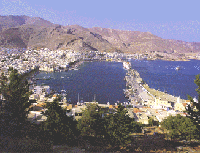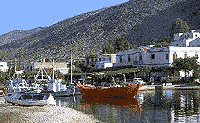 As in classical times, sponge fishing remains the chief industry, with the sponge fleet away to the North African coast for up to six months each year after Easter. Toward the centre of the island, the volcanic valley of Vathys, irrigated from springs, supports citrus, olives, figs, and vines. The island is the seat of a metropolitan bishop of the Greek Orthodox Church.
As in classical times, sponge fishing remains the chief industry, with the sponge fleet away to the North African coast for up to six months each year after Easter. Toward the centre of the island, the volcanic valley of Vathys, irrigated from springs, supports citrus, olives, figs, and vines. The island is the seat of a metropolitan bishop of the Greek Orthodox Church. Believed to have been settled by a Dorian colony from Epidaurus in the Peloponnese, the island coined its own money and took part in the first and second Athenian leagues (5th and 4th centuries BC). As a Persian satrapy, it was conquered in 332 by the Macedonian forces of Alexander the Great and was later annexed by Rome to the province of Asia. Until AD 1310 it was occupied by Venetians,
who then gave way to the Knights of Rhodes (the future Knights of Malta). In 1522 it was captured with the other islands of the Dodecanese by the Turks, and in 1912 it was occupied by Italy.The people of Kalimnos resisted Italianization, and during World War II many fled to Turkey. The necropolis of Damos and more than 100 ancient Greek inscriptions are among the antiquities found or excavated on the island.Kalymnos or Pothia, the island's capital, is amphitheatrically built, and descends to the portlike a multicoloured torrent of bright houses, churches and belfries. On the coast lies the church of Jesus Our Saviour; its interior is decorated with murals and old icons painted by local artists. The temple has been constructed by Giannoulis Halepas, the famous Greek sculptor. With the city as a base you can visit the wonderful countryside and villages.
 In the southwestern part of the island you can find the cave of Kefala (or Trypa), with its stalactites and stalagmites, as well as the caves of the Seven Virgins (or Cavern of the Nymphs) at the foot of mount Flaska. In the SW of the island you will find the cave of Scalia the Therma -radioactive springs (about 1 km south to the city) are recommended for the cure of many illnesses.
In the southwestern part of the island you can find the cave of Kefala (or Trypa), with its stalactites and stalagmites, as well as the caves of the Seven Virgins (or Cavern of the Nymphs) at the foot of mount Flaska. In the SW of the island you will find the cave of Scalia the Therma -radioactive springs (about 1 km south to the city) are recommended for the cure of many illnesses.
Therma is equipped with modern bathing facilities, specialised personnel and rooms for visitors. Horio, the old capital of the island, is built at the foot of the medieval castle. Around Horio the remain ruins of the church of Jesus of Jerusalem , built towards the end of the 4th century AD, can be found.To the southwest are the monasteries of the Evangelist and St Catherine, both equipped with hostels for visitors. On the 27th of July, the island celebrates the feast of St Panteleimon with parties, folk dances and songs. Along the island's western coast there are many places beauty - Linaria and the villages Myrties, and Masouri. With it's tiny bays and surrounding islands, Kalymnos is ideal for amateur fishermen, and its transparent seas are ideal for scuba-diving enthusiasts. Visitors of Kalymnos also have the chance to taste traditional local dishes: "lei", "mirmizeli", "psises". From Kalymnos youcan easily visit the nearby tiny islands of Telendos and Pserimos, which offer idyllic sites for swimming and fishing. For those cruising theGreek islands yacht refueling stations can be found in Kalymnos.The most beautiful beaches are on the west coast of the island and includes Panormos, Kantouni, Linaria and Plati Gialo. Other beaches on the west coast are Mirties, Masouri, the gulf of Arginonta and Emborios.On the east coast of the island there are beaches in Ormo Akri and at the harbor of Bathi. For night entairtenment in Pothia there are bouzoukia, discos, bars and a cinema.Restaurants, taverns, discos and bars are also available in Masouri and Mirties.Pop. (1991 prelim.) island, 16,407.

